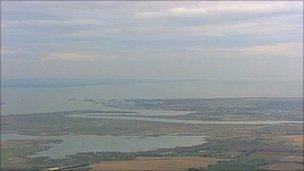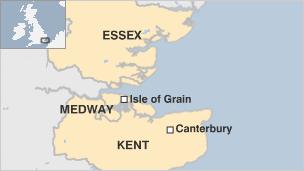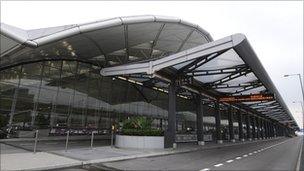Lord Foster behind Kent airport plan
- Published

The airport would be built partly on the Isle of Grain and partly in the Thames Estuary
Renowned architect Lord Foster is behind the latest attempt to open an airport in the Thames Estuary.
His firm has drawn up a £100,000 study which would place the gleaming £50bn airport on Kent's Isle of Grain.
The plan is described as allowing London to compete with airports in Europe and the Middle East.
But one opponent branded the idea as the "daftest in a long list of pie-in-the-sky schemes".
A similar plan by London Mayor Boris Johnson for an airport in the Thames Estuary, known as "Boris Island", was ruled out as an option by Prime Minister David Cameron last year.
And an airport at Cliffe in Kent has also been considered but was rejected by the Labour government in 2003.

Which begs the question: Why is Lord Foster's proposal any different?
The architects say it represents a "significant development" on Boris Island.
Asked whether the new Thames Hub had a better chance of becoming reality, partner Huw Thomas said they were looking at the "big picture" over the next 30 years.
"You could call it thought leadership," he said.
"It's really an opportunity for people to discuss where we want to be as an economy 30 years from now rather than being driven by a five-year view.
"How do we get locked into global trade? How do we give ourselves a pre-eminent position again?"
"This is very much about connecting the estuary hub into the West Coast mainline and up to Liverpool.
"We are the only country in Europe that can have a west-facing Americas port at Liverpool and an east-facing - China, India, Europe - port in the estuary."
Lord Foster's scheme for airport to replace Heathrow would have four runways.
It would be powered by a tidal energy barrage and built partly on land and partly in the estuary. There would also be new flood protection to replace the existing Thames Barrier.
Yet, all this cuts little ice with leader of Medway Council Rodney Chambers.
He said the government and "many airline industry giants" had already said they did not support a new airport on or near the Thames Estuary.
"The Isle of Grain is home to the largest Liquefied Natural Gas terminal in Europe and around a fifth of the UK's gas supply is offloaded by container ships and stored there," he said.
"It is plainly obvious that aircraft and huge gas containers are a potentially lethal mix.
"I can only assume that neither Lord Foster nor Boris Johnson have actually left their offices and travelled from London to the Isle of Grain to have a look.
"This is the daftest in a long list of pie-in-the-sky schemes".
The RSPB, which opposed the previous airport plans, believes the latest idea will join the ranks of schemes never built.

Hong Kong's Chek Lap Kok airport, designed by Lord Foster, was built on reclaimed land
"There have been proposals in the Thames Estuary for 40 to 50 years, going right the way back to Maplin Sands," said Paul Outhwaite, RSPB South East spokesman.
"It's been shown time and time again that the estuary is not the right place for an airport."
The RSPB began counting water bird numbers in the 1960s in response to the proposed Maplin Sands airport off Essex.
It counts the Thames Estuary as one of the top five most important sites in the UK for water birds wintering or migrating.
Mr Outhwaite said the charity took all development plans seriously, particularly one as detailed as the Thames Hub.
"We have got to demonstrate that we would no more knock down Canterbury Cathedral to build a new supermarket than we would destroy our most important wildlife sites for a new airport," he said.
"That part of the estuary is used by tens of thousands of waders and wildfowl in the winter and there is nowhere else for them to go."
Foster and Partners is to release more details of the scheme in September.
- Published18 January 2011
- Published27 October 2010
- Published2 July 2010
- Published24 October 2010